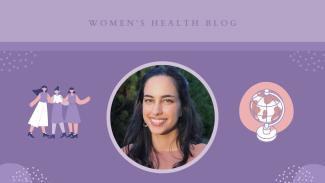Interviewee: Naseeb Bolduc, B.A.(Hons), MSc | Authors/Editors: Arrthy Thayaparan & Negin Nia (Blog Co-coordinators)
Published: April 22, 2022
The sciences contain a variety of subject areas, with some receiving more attention than others. One often overlooked area is research in the social sciences, including the study of society and policy.
Naseeb Bolduc, a researcher at the B.C. Center of Substance Use, is currently coordinating a study that looks at the social impacts of the COVID-19 pandemic. The Women’s Health Research Cluster spoke to her to learn more about her research.
Could you briefly explain what your research is?
I'm the research coordinator for the FOCUS study! It’s an international mixed methods study that looks at the wellbeing of youth who are under 30 and living in Canada and France in the context of the pandemic. Our aim is to amplify the perspectives and opinions of young people to inform social, economic and health policy responses to the pandemic.
How did you become interested in women’s health?
I did not originally start in public health! I majored in philosophy at UBC as an undergrad. I was really interested in how philosophical concepts like justice, power, and autonomy were being applied in the field of public health, and how this was being explored in the subfield of public health ethics. Once I started studying public health as a Master’s student, I learned in-depth about the social determinants of health. A lot of that looks at gender, and gender-based inequities, as a really important determinant of population health.
What inspired you to study the social determinants of health?
Well, I was always interested in the idea of justice in public health, but I started my MSc in Population and Public Health in 2018, before the pandemic. When COVID emerged, as a student researcher at the time, I noticed how the media was specifically reporting on young people, young people's behaviors, and what their role was in the pandemic.
I don't know if you remember, but there were many stories about how people in their 20s were the vectors of illness, and how they were behaving irresponsibly and endangering others. I had such an interesting perspective on that as a young person and as a researcher in public health - particularly because it was striking to see a subgroup of people being blamed for a population-level problem. And belonging to that subgroup, I knew that the situation wasn’t so black and white. I’m sure some young people were being careless, but what about those (like many of my friends) who were essential workers? I started to wonder how the pandemic was changing life for different groups of young people, or different groups of people in general, whether it was based on their age, gender, or where they are in the world. And, of course, how the pandemic is inequitably leading to different health outcomes, because some people are being impacted by public health-related policies, and by the virus itself, a lot more than others.
How did you find the shift from the Humanities into a Public Health field?
There are huge differences between the two! For me, one of the biggest shifts was the idea of working and writing very independently in philosophy, versus in public health, where you're working with other people, and you're really generating knowledge as a group. And I just love being part of a team so much - that's definitely a factor that's going to keep me in public health.
Another big difference is the fact that right now my work uses empirical data. I think there's something really special about doing work that's grounded in real life. Every piece of information we collect, every data point, is something that has been given to us by a participant who's really living that experience. As researchers, we have the incredible opportunity (and a responsibility, I think) to do something meaningful with that data.
What is misunderstood or not known as much about your field or work?
I think one misconception is that when people hear that I have a Master of Science and that I work in public health on a study about the COVID-19 pandemic, they immediately picture a traditional white-coat-mixing-chemicals-in-a-lab situation. However, I actually spend most of my time talking or reading, because the study that I’m working on explores the impact of the pandemic through a social science lens. Our team wants to understand things like how young people feel about vaccines and vaccine passports, how their social lives have changed because of the pandemic, and what impact this has all had on their emotional wellbeing. Perhaps most importantly, we also want to understand what they want their futures to look like, and what policies and sources of support can help them get there.
I think, based on what we’ve seen over the last two years, it’s clear that this social side to public health is critical for progress. Because no matter how much we understand about the virus, the way people feel about the pandemic and pandemic-related policies will have a significant impact on everyone’s health and wellbeing. As a researcher, this social side to public health is also the key to understanding health inequities, and figuring out how they can be reduced!
